If you’re planning your first trip to Japan and seeking an immersive cultural experience, Kyoto is the perfect destination. With its rich history, classic Japanese architecture, and serene natural surroundings, Kyoto offers a unique charm that sets it apart from the bustling metropolises of Tokyo and Osaka. Exploring its culture should be at the heart of any 5 day Kyoto itinerary.
As you step foot in this enchanting city, you’ll immediately notice the stark contrast to the modern skyscrapers that dominate other urban landscapes. Kyoto proudly preserves its traditional architecture, with temples, shrines, and wooden machiya houses adorning its streets. This preservation of historical beauty creates an atmosphere that takes you back in time, allowing you to immerse yourself in the ancient traditions and customs that have shaped Japan’s cultural identity.
Surrounded by lush green mountains, Kyoto also provides a more serene retreat from the concrete jungles and the city’s natural landscape offers breathtaking views, particularly during the vibrant cherry blossom season and the stunning autumn foliage.
It is hard to say which city we loved the best during our two-week family trip to Japan because they are each so different, but I truly believe you shouldn’t go to Japan and not visit Kyoto.
Throughout this five-day Kyoto itinerary, I will guide you through the highlights of Kyoto, ensuring that you make the most of your visit. From choosing the perfect accommodations to experiencing the must-visit landmarks, I’ll cover it all. Indulge in delectable local cuisine at our recommended restaurants and find out how to splurge on an unforgettable cultural experience.
Five days may seem like a lot in Kyoto, but since the attractions are spread out and there are quite a few important shrines and temples to include in your Kyoto itinerary, it is quite easy to fill the time and still wish for more. Plus, five days provides the opportunity to take a day trip to nearby Nara.
Do you need help planning your trip? If you are feeling overwhelmed and don’t have the time or resources to wade through tons of information and question your decisions, I help clients plan a custom itinerary, tailored to your interests and travel style. Learn more about my trip planning services.
5 Day Kyoto Itinerary: Day 1
Note: This post may contain affiliate links. If you click a link and make a purchase, I may receive a small commission. All opinions are my own.
I’ve written this itinerary for visitors that are coming from Tokyo on the Shinkansen and planning to take a day trip to Nara before settling down in Kyoto, following the Japan itinerary that I created for our recent trip. If you are arriving directly into Kyoto, or prefer to start exploring right away, you can easily switch around the days to suit your needs.
Day Trip / Stop in Nara
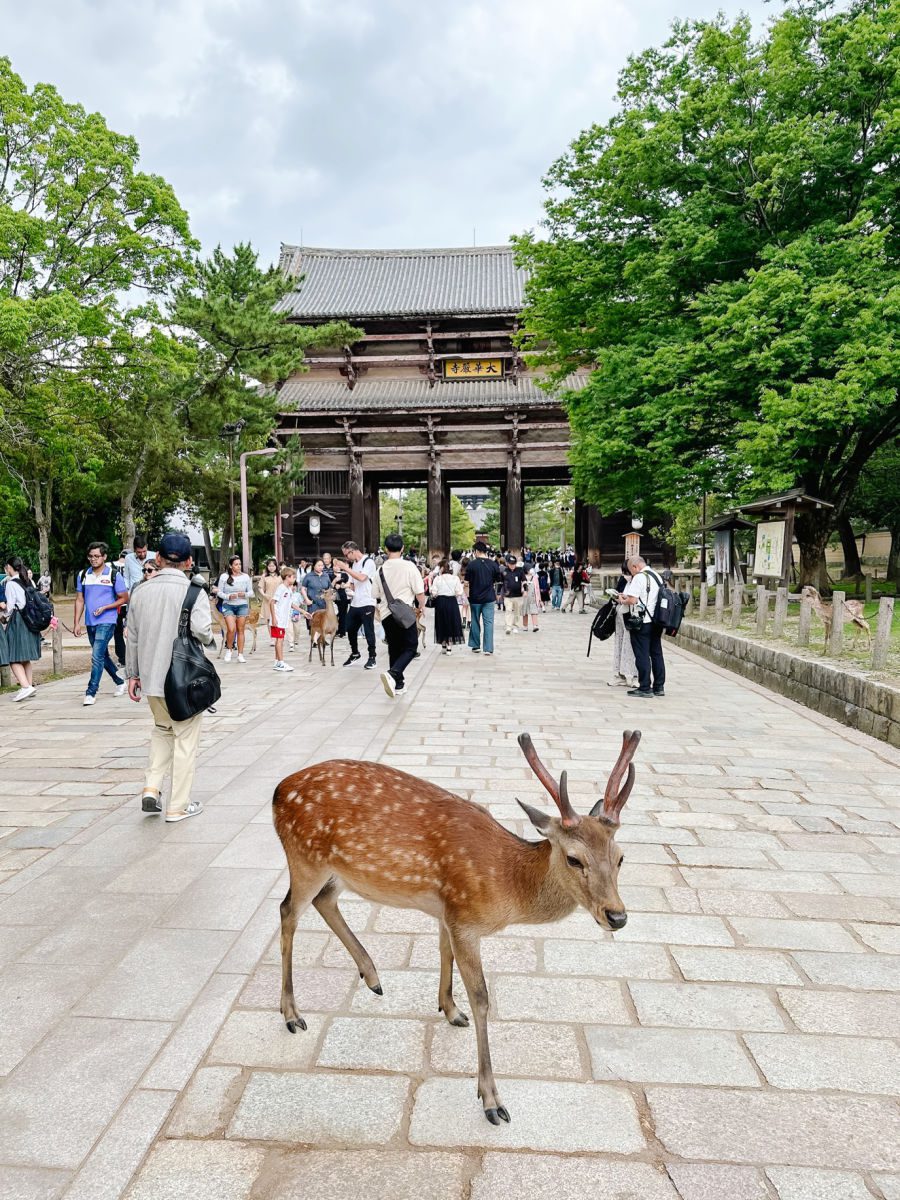
Take the Shinkansen (bullet train) from Tokyo Station to Kyoto Station. Here, you will need to switch to the JR Nara line (or the faster Kintetsu line, which is also closer to the Nara attractions — but isn’t included in the JR Pass.)
When you arrive in Kyoto, simply store your bags in one of the lockers (lockers cost about 400-600 yen and you can pay using your IC card) to retrieve them when you return, and then jump on one of the local trains. You can then take a bus from the JR train station or walk from the Kintetsu line to the main attractions in Nara.
The main attractions are the Todaiji Great Buddha Temple, a UNESCO World Heritage site, and the Kasuga Shinto Shrine. You get to both by walking through the Nara Deer Park.
Back when my husband first visited Nara 25 years ago, the gentle deer would kneel politely to ask for food. These days, if you purchase crackers for the deer, you will be stalked, as the deer have gotten much more aggressive. They nipped at us, pulled on our shirts, and even chased us. If you don’t want to be bothered by the deer, don’t hang out where the food vendors are, and don’t carry any food or paper in your hands.
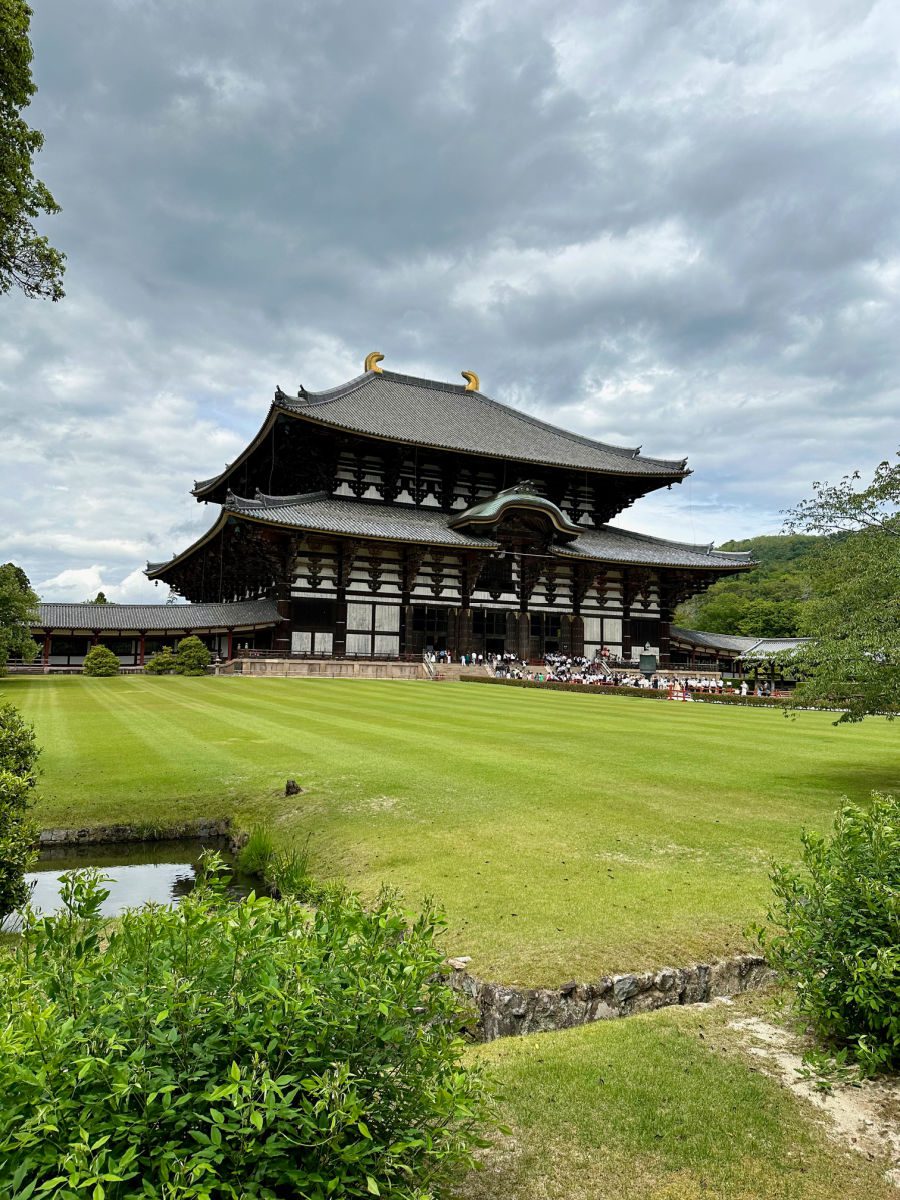
Built in 752 by Emperor Shomu, the Todai-ji Temple is an incredibly impressive structure and is reputed to be the largest wooden building in the world. It also houses one of the world’s largest bronze statues of Buddha, standing around 15 meters (49 feet) tall.
Constructed in the 8th century, during the Nara period, it was commissioned by Emperor Shomu with the aim of promoting Buddhism and establishing a symbolic center for the religion in Japan. The enormous bronze Buddha represents Vairocana, the cosmic Buddha, and showcases the remarkable craftsmanship of ancient Japanese artisans, flanked by statues of Bodhisattvas and surrounded by other significant Buddhist figures and deities.
The Todaiji Temple and its Great Buddha have faced various challenges and reconstructions throughout history, including damage caused by fires during Civil Wars and earthquakes. Nonetheless, the temple has been rebuilt each time and is really a must-visit destination in Nara.
If you have more than two hours in Nara, you can also explore more of the Isuien Garden, a traditional Japanese garden featuring beautiful ponds, tea houses, and meticulously manicured flora. You can also stop at the small museum near the temple.
With a whole day in Nara, you would have time to hike up Mount Wakakusa for a panoramic view of Nara city and its surrounding landscape. However, we wanted to get back to Kyoto because I’d scheduled a walking tour that evening and we needed to check into our hotel first.
Evening Tour of Gion
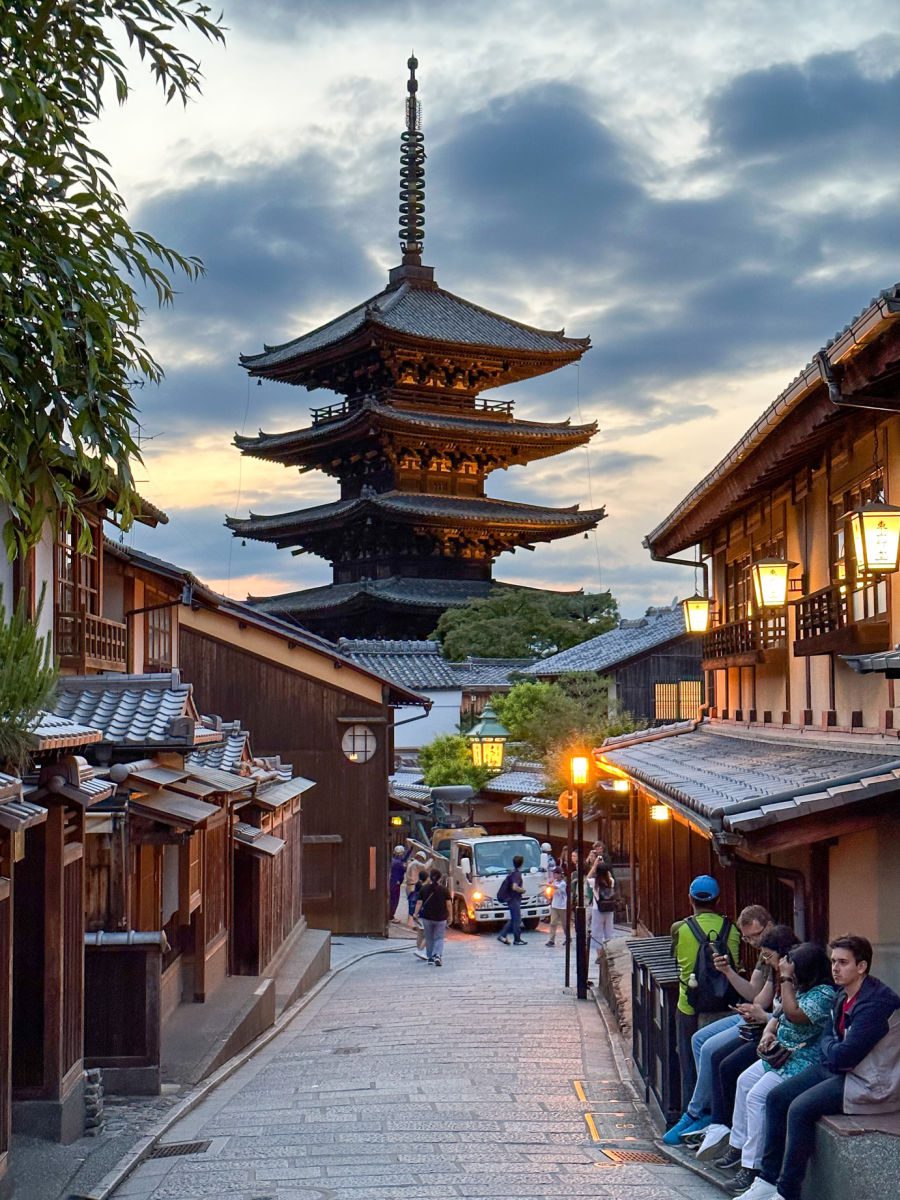
Plan to arrive back in Kyoto in time to check in to the hotel around 4:00 pm. To get a sense of the city’s most popular tourist district, I booked a Gion Night Walk tour with Kyoto Fun.
Our guide for this small group tour was a French ex-pat who had been living in Kyoto for 20 years and knew the area and the culture quite well. He was also very relatable and conducted the tour in excellent English despite having a group consisting of people from Iceland, Spain, Argentina, and the USA.
This historic area is filled with temples, shrines, restaurants, shops, and homes in traditional architecture. While it is crowded and chaotic during the day, in the evening it is quiet and actually quite magical. The tour starts off in an area where you can often see Maiko (apprentice geisha) and Geiko (what they call geishas in Kyoto) heading off to their evening appointments.
When you see a Maiko or Geiko, it is important to step aside and not get in their way or try to take a selfie, jump in front of them to take photos, etc. It is considered extremely rude. You can stand off to the side and take photos of them as they are walking by as part of the landscape or street photography. I have heard that they have since barred tourists from these streets because they have been too aggressive with the Maiko or Geiko, so I’m not sure how that impacts guided tours.
The tour also took us past the Kenninji Temple (Japan’s oldest Zen Temple), through other smaller shrines, past the Yasaka Pagoda just as the sun was setting, and then through the Ninenzaka path and other small streets before ending at the Yasaka Shrine.
We really loved this tour and getting to explore this area at night with a guide that explained so much about the culture and history, but in a laid-back and chill way that allowed you to soak it in and enjoy the atmosphere and not get bombarded with facts. If you walk these streets during the day, you will see what a difference it makes in the crowds, making it hard to get through and appreciate its beauty.
The tour ends in Gion, where there are so many different restaurants to choose from. Since it was late and we didn’t have a reservation, we waited in a short line at a small okonomiyaki place recommended by our tour guide but a few other spots I had on our radar included:
- Yakitori Daikichi Japan, Ohashicho, 18−2
- Gyoza Hohei 373-3 Kiyomotocho
- Gion Tanto (okonomiyaki) 372 Kiyomotocho
Kyoto Itinerary: Day 2
On our second day in Kyoto, we decided to explore the Fushimi district, which is a bit south of the city and home to the Instagram-famous Fushimi Inari shrine, which has a pathway through 10,000 vermillion torii gates. This is one of the most important Shinto shrines in the city and also one of the most popular tourist attractions.
Fushimi Inari Shrine
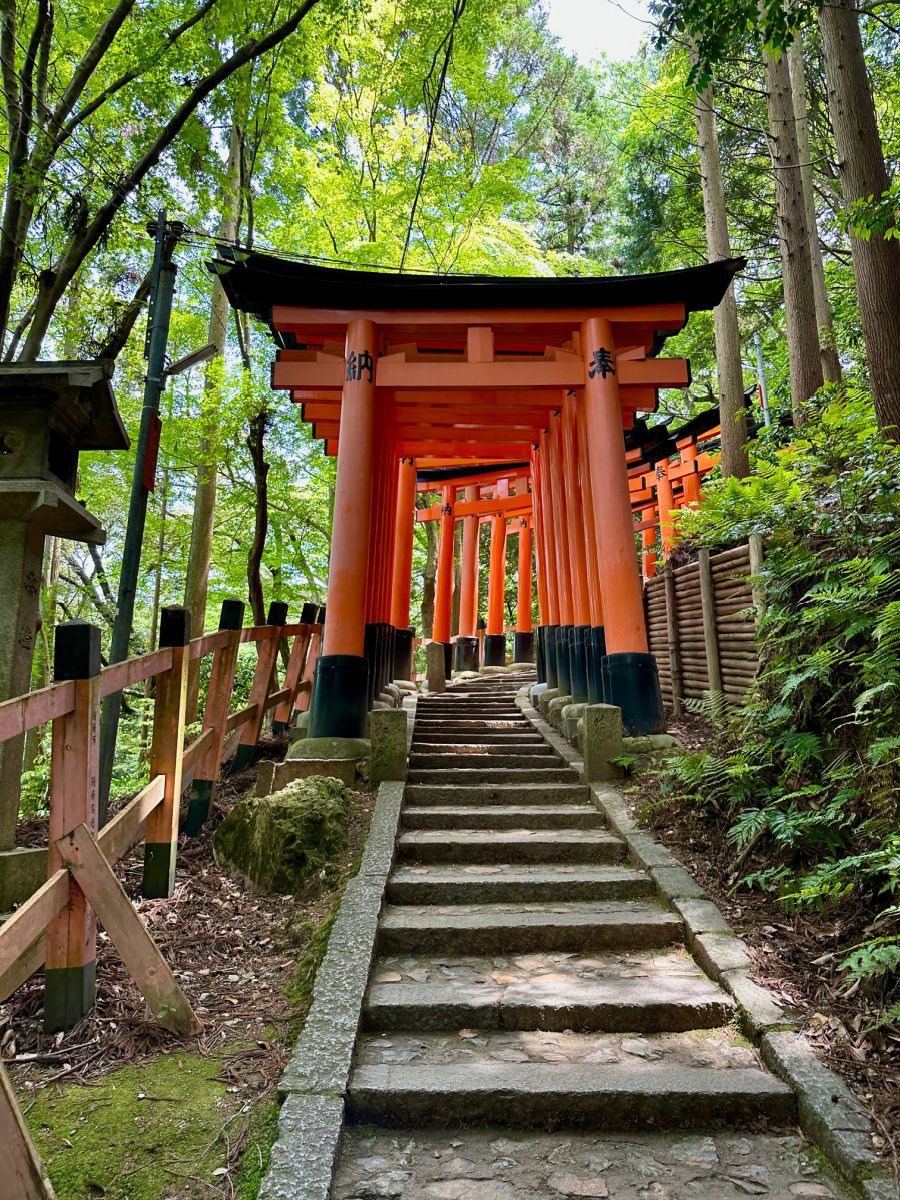
The Fushimi Inari Shrine is dedicated to Inari, the Shinto deity of rice, agriculture, and prosperity. Inari is often represented by foxes, and you can find numerous fox statues throughout the shrine grounds. The complex consists of multiple sub-shrines and trails leading up to Mount Inari, lined with the vibrant vermillion torii gates.
It is ideal if you can visit during a weekday (although still expect crowds) and arrive early (around 7-8:00 am) before the tour busses start to roll in. To get there, it is a one-minute walk from the Inari Station on the JR Nara Line, which you can pick up from the main Kyoto Station. Alternatively, you can take the Keihan Main Line train to Ryukokudai-mae-fukakusa Station and walk a bit further to the shrine.
If you want to have breakfast before you begin to explore, don’t follow the main crowd through the gates but stay to the left and follow the path to the Vermillion coffee shop for coffee/pastries and breakfast dishes such as avocado toast.
Many visitors skip right past the main shrine to begin the climb up the mountain through the thousands of torii gates. In the beginning, you need to shuffle along with the crowd, but many people turn back after the first set of gates. Others only make it as far as the scenic overlook about halfway up the mountain, which offers views of the city below and the mountains in the distance. Luckily, the further you go the fewer the people and it is much easier to enjoy the experience and capture photos.
If you choose to climb all the way to the top, your entire visit will take about two hours, perhaps longer depending on how fast you climb and how many shrines you stop at along the way. Keep in mind that there any many flights of steep steps (my Apple Health app tracked it as 59 floors) so dress comfortably and wear good walking shoes. The path is mostly shaded but you should bring along water. However, there are small shops selling water, tea, ice cream, and sweets along the path and there is a restroom at the bottom and about halfway up the path.
As you walk along the path, you will notice writing on each of the gates. Each gate is donated by individuals, families, or businesses and represents a wish or prayer. We later heard that some businesses have been on a waiting list for decades to sponsor one of the gates.
At the top, you will find another shrine, which is a bit nondescript albeit for the small sign that says “top”, but it is a relief to see after all the climbing. Here you can offer prayers or make a donation to see your fortune.
Going back down is a bit easier, although not as easy on the knees. If you are short on time, I would recommend just climbing to the scenic overlook. By then the crowd should have thinned out sufficiently to get a few nice photos and you will have gotten the feel for the experience without having to make the entire climb.
Fushimi Sake District
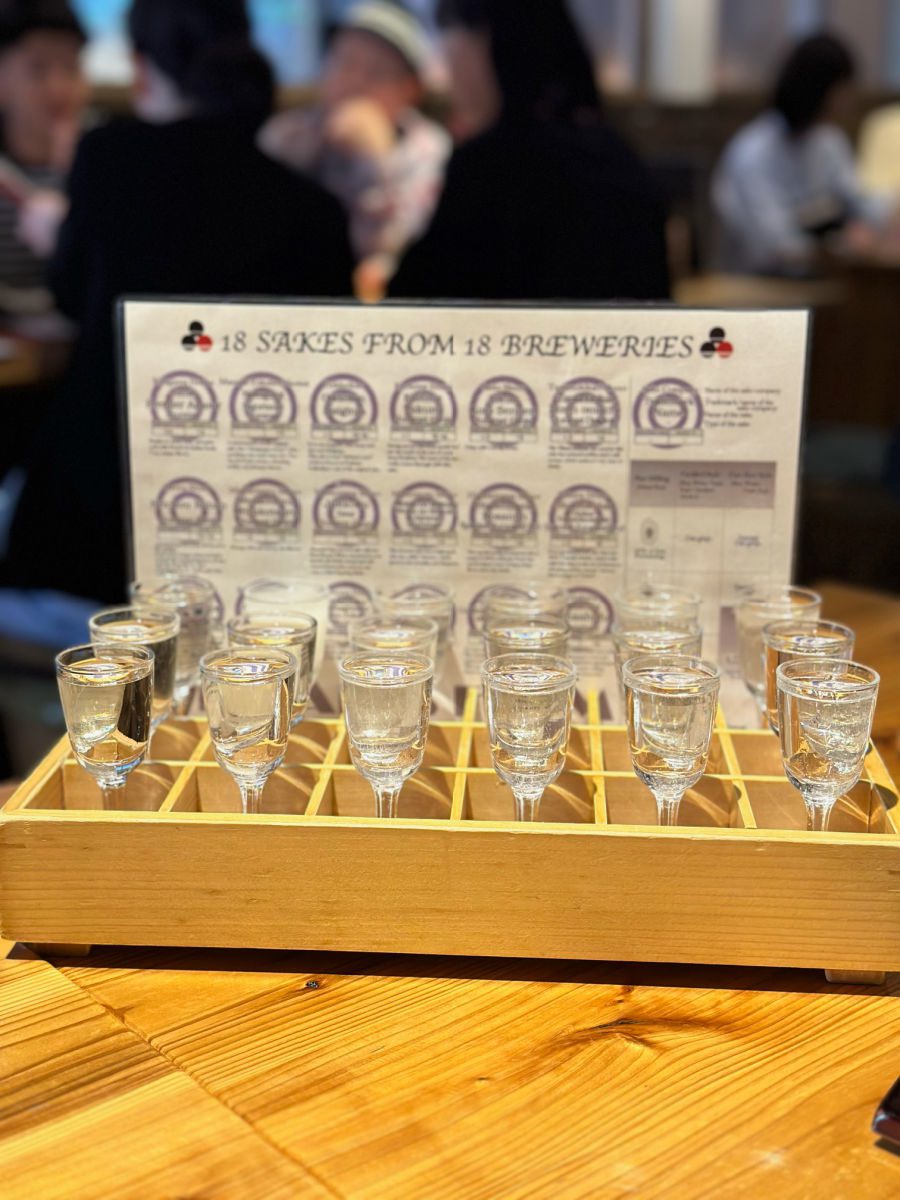
After all that climbing, you will want to reward yourself with a drink and some good food. You can find both in the Fushimi Sake District. Located just a short train ride from the Fushimi Inari Shrine, this area is off of the main tourist path and home to over 30 sake breweries.
The district has a rich history dating back over 400 years, and its location near the pure water source of the Fushimi River has contributed to the high-quality sake production. One of the highlights of the area is the Gekkeikan Okura Sake Museum, which provides insight into the sake-making process and the history of sake brewing in the region.
In addition to the museum, Fushimi offers plenty of opportunities to explore the local breweries and sample different types of sake. Many breweries open their doors to the public, allowing visitors to observe the brewing process, interact with knowledgeable brewers, and taste a variety of sake flavors. There are a number of sake-tasting tours that you can take in this area, but you have to be 20 (Japan’s drinking age.)
If the tours don’t work for you (like us with our 19-year-old), you can still sample sake from many of the local breweries at the Fushimi Sake Village. This spot is a bit hard to find and tucked away from the main shopping arcades but trust Google Maps and you will get there.
Within the Fushimi Sake Village, there are multiple restaurants and multiple tasting bars, but you can get a table in the center and order a sake sampler of up to 18 different sakes, along with food from multiple restaurants. Try the gyoza (I forget which restaurant they were from but it was the best gyoza we had on the trip!) You may want to split a sampler but it is a fun spot to spend the afternoon.
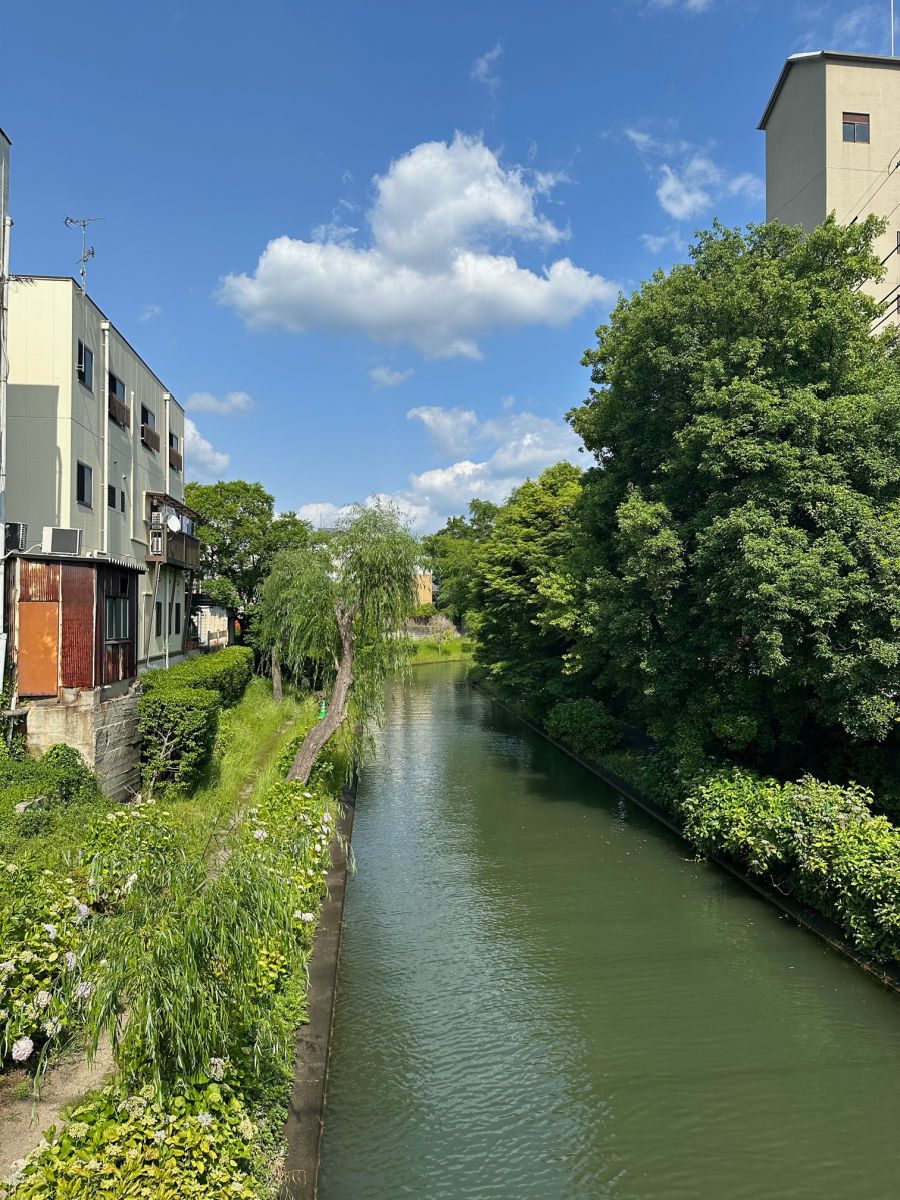
Aside from the sake-related activities, the Fushimi sake district is also a picturesque area to explore, with charming streets, traditional wooden townhouses, and scenic canals. To enjoy the canals, you can take a ride on a traditional Jikkokubune boat, which is especially beautiful during Cherry Blossom season or fall foliage. And if you need something sweet to soak up the sake, the doughnuts at Nayamachi Fushimi are the perfect choice.
Private Kaiseki Dinner with a Maiko
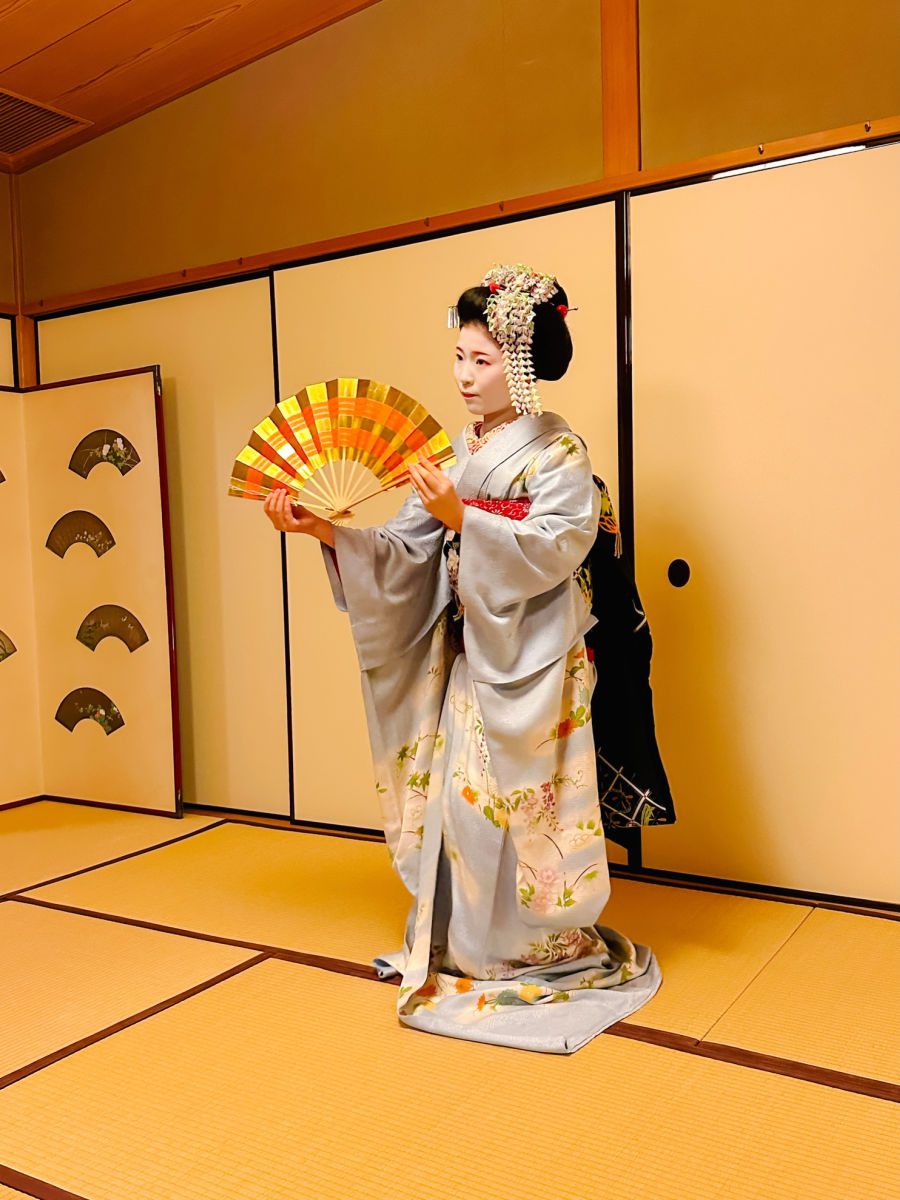
If you are willing to splurge for a truly unique and memorable cultural experience, I’d recommend booking a private kaiseki dinner with a maiko and/or geiko. It is not easy to make a direct booking with a teahouse because this is usually done by someone with personal connections to the teahouse or the management company of the maiko or geiko. You may want to reach out to your hotel concierge, but I was able to arrange this through a third-party booking service and tour company.
It is quite expensive but truly a once-in-a-lifetime experience. We were met by our interpreter at our hotel and we traveled to the teahouse by taxi. There we met the owner of the teahouse and then were joined by a maiko (geisha apprentice) and geiko (geisha).
Throughout our multi-course traditional kaiseki meal, we were able to chat with the girls through our interpreter and learn so much about this tradition and culture, including the training, the attire, the skills, and the differences in appearance between a maiko and a geiko. I will admit that I had a hard time with some of the traditional dishes, as I’m not a fan of raw fish, but I’m glad we had the chance to experience this tradition.
After dinner, both girls gave a short dance performance and then we played some rhythm games together. It was so interesting to see how this culture is preserved, but also the modern influences, such as various geiko or maiko houses having an Instagram account.
I know there are some misconceptions of this culture that equates it with prostitution (which it is NOT) or see it as exploitative, but I can assure you that these girls have dreamed of becoming a geisha and have to go through a very rigorous application and training process.
Kyoto Itinerary: Day 3
For our third day in Kyoto, we wanted to explore more of the eastern side of the city and the Higashiyama ward, including some of the famous temples, shrines, and shopping areas. If you follow this itinerary, you will want to wear comfortable shoes but consider shoes that slip on and off easily for entering temples as many require you to leave your shoes in cubbies at the door.
Since we were staying right next door at the Hyatt Regency, we started the day at the Sanjusangendo Temple. While you can’t take pictures inside, this temple houses 1001 almost life-sized carved and gold-plated images of Kannon, the goddess of mercy. It only takes a few minutes to visit, but it is quite a sight to see.
From there, it is a 20-minute walk to Chawan-zaka or ‘teapot lane’, which is a good spot to shop for pottery with beautiful handcrafted designs. Follow this road up the hill to Kiyomizudera Temple.
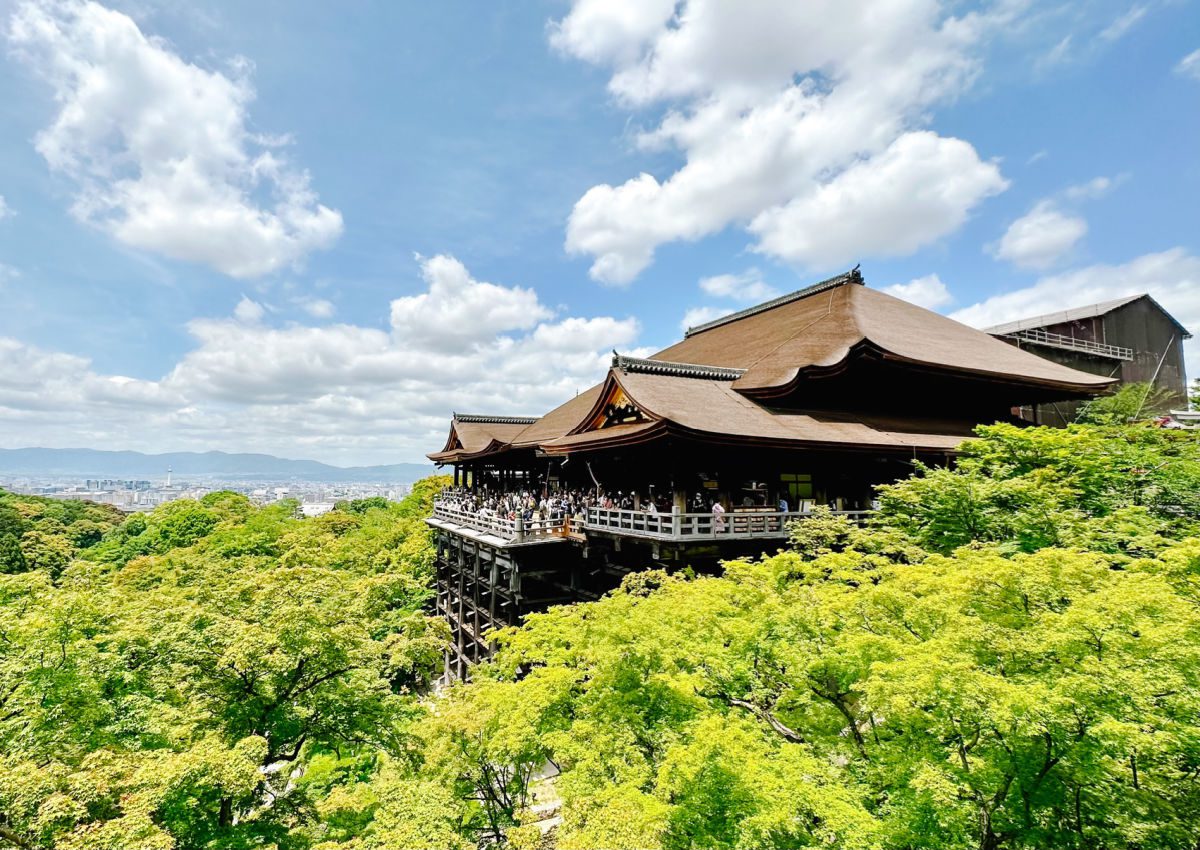
Built in the 8th century, this UNESCO World Heritage site sits on a hillside, offering panoramic views of the city below. The temple’s most iconic feature is its wooden terrace, which juts out from the main hall and provides a vista of the surrounding landscape. Another popular spot to visit within the temple grounds is the Otawa Waterfall, which is believed to have sacred waters with healing properties. Visitors can use long-handled cups to drink from three streams, each said to grant a different benefit: longevity, success in studies, and love and relationships.
Kiyomizu-Dera Temple also offers a tea house and you will find many vendors selling sweets, local crafts, souvenirs, and good luck charms.
After visiting the temple, walk through the Gion district and explore the many shops and stalls offering sweets and street food. The most popular shopping streets are Sannenzaka, just down the hill from the temple, and Ninenzaka Street, where you will even find a Starbucks. This area is certainly more crowded during the day, but it is a good opportunity to visit while the shops are open.
Next, you can visit the Kodai-ji Temple and the Yasaka Shrine, which you may have already seen during the evening Gion walking tour. The Kodai-ji Temple was established in 1606 by Kita-no-Mandokoro, also known as Nene, in memory of her late husband, Toyotomi Hideyoshi. This zen temple includes meticulously maintained rock gardens, lush greenery, and tranquil ponds that create a peaceful atmosphere.
The main hall is a designated national treasure and houses intricate Buddhist statues, including a statue of Nene. Inside, you can also admire the exquisitely painted fusuma sliding doors and detailed woodwork that reflects the artistic craftsmanship of the Momoyama period.
By this time, you may be getting temple fatigue, but there is one more that you shouldn’t miss — Ginkaku-ji Temple. However, if you have the energy, you can first visit the Nanzen-ji Shrine and then walk along the Philosopher’s Path (Tetsugaku-no-Michi), which is a stone path following a canal running through the Higashiyama district. It is lined with cherry trees, so this is particularly beautiful during the Cherry Blossom season. The Philosopher’s Path connects the Ginkaku-ji temple and the Nanzen-ji Temple.
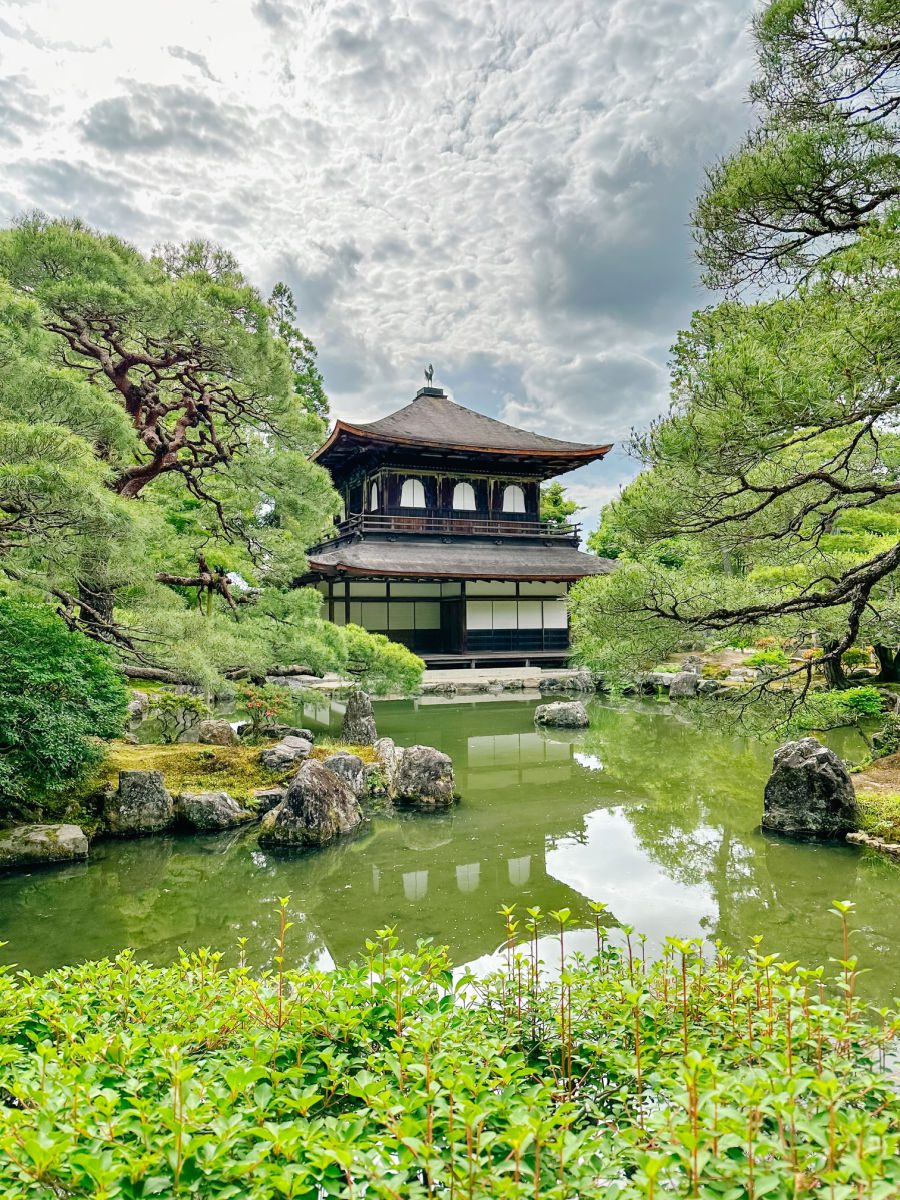
The Ginkaku-ji Temple is also known as the Silver Pavilion because it was originally intended to be covered in silver leaf (in contrast to the Golden Pavilion, which is covered in gold leaf.) This renowned Zen Buddhist temple was built in the late 15th century and is an example of Japanese aesthetics and Zen philosophy, offering a peaceful atmosphere, if you can manage to escape the crowds.
The temple grounds feature perfectly landscaped gardens, including the iconic sand garden known as the Sea of Silver Sand, with is designed to mimic the ripples of a calm sea. Other attractions within the temple complex include moss-covered pathways, a stone garden, and a picturesque pond adorned with stone bridges.
For dinner, I’d recommend taking advantage of Kyoto’s fantastic fine dining options. Since we were celebrating both our anniversary and our daughter’s birthday on the trip, we decided to splurge on a special sushi dinner at Gion Matsudaya. This acclaimed six-seat sushi restaurant books up weeks in advance, so I would suggest booking a reservation as soon as possible. All dinners are served omakase-style, which means it is the chef’s selection of sushi versus an a la carte menu.
Kyoto Itinerary: Day 4
On day four in Kyoto, it is time to explore the Western side of the city. Of course, you can always rearrange these days to best suit your schedule if you don’t want to have two back-to-back days visiting temples and shrines. Also, since these sites are located along the same train line as the Arashiyama Bamboo Forest, it is possible to visit both areas in one day if you have less than five days in Kyoto.
We booked a morning tour with True Japan to visit the Ryoanji Temple, with its famous rock garden, and the Kinkaku-ji Temple, which is more commonly known as the Golden Temple. I’ll be honest with you and tell you that I don’t think it was worth it. Maybe with a better guide from a different tour company, but these are easy to explore on your own. Our guide was extremely soft-spoken and hard to understand with limited English, so unfortunately we only got very cursory information about these sites and she wasn’t able to answer some of our follow-up questions.
the Golden Pavilion & The RYOAN-JI TEMPLE
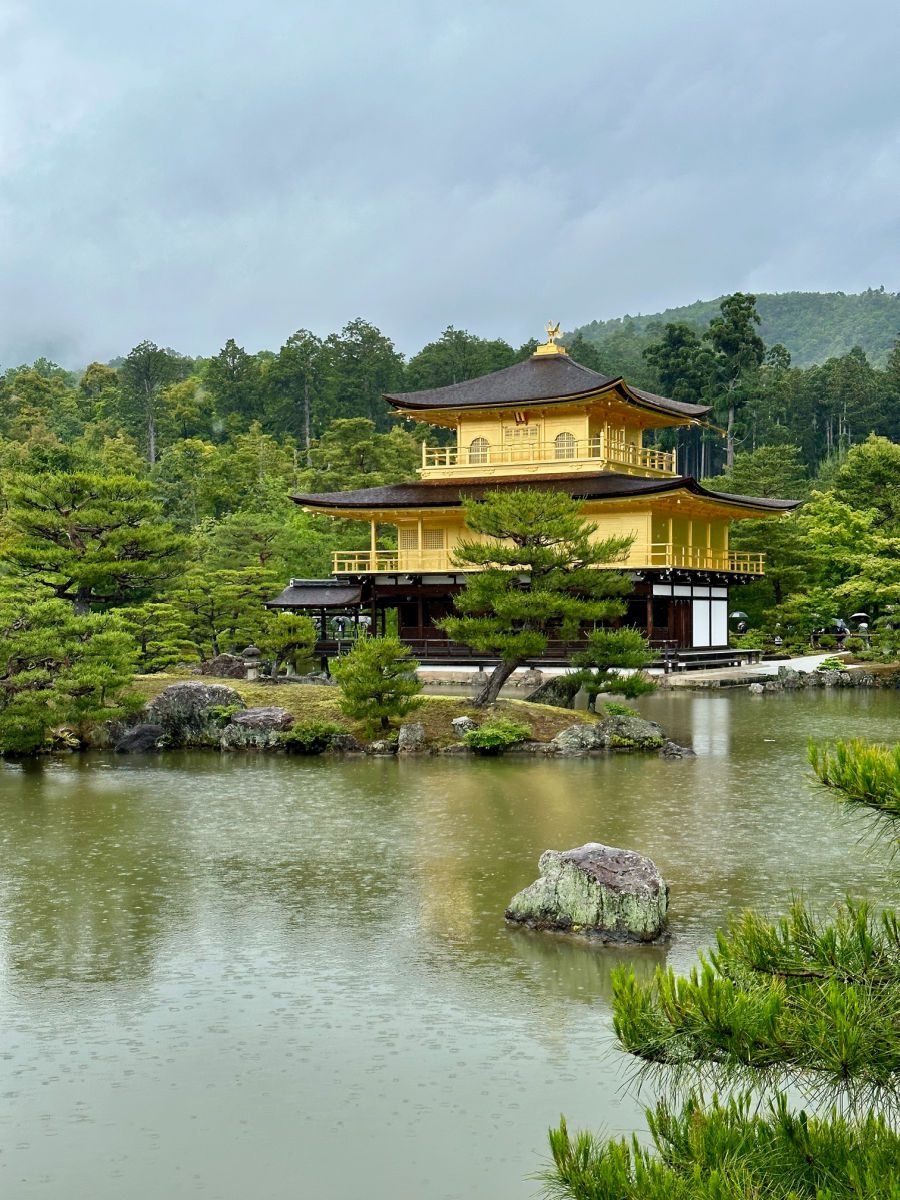
The Kinkaku-ji Temple, also known as the Golden Pavilion, is one of the most iconic and popular tourist attractions in Kyoto. The temple’s shimmering golden exterior is often featured on guidebooks and other tourism materials.
Built in the 14th century, the temple was initially a retirement villa for shogun Ashikaga Yoshimitsu. However, upon his death, the villa was converted into a Zen Buddhist temple, as per his will. The temple’s construction and design were influenced by the shogun’s desire to create a serene and harmonious place for meditation and reflection.
You can observe the temple exterior from various viewpoints, including across the pond or from the adjacent Kyōko-chi (Mirror Pond) and the gold really shines, even in the rain. While the interior of the temple is not open to the public, you can also visit the Sekkatei teahouse and the Anmintaku Pond, explore the gardens, engage in tea ceremonies, and purchase souvenirs or omikuji (fortune-telling slips) from the temple grounds.
From the Kinkaku-ji Temple, it is a short bus ride to the Ryoan-ji Temple. The Ryoan-ji Temple was originally a country house of the Tokudaiji Clan, but it was later turned into a Zen training temple. It was destroyed by a fire during the Onin War but rebuilt in 1499 and registered as a World Heritage Site in 1994.
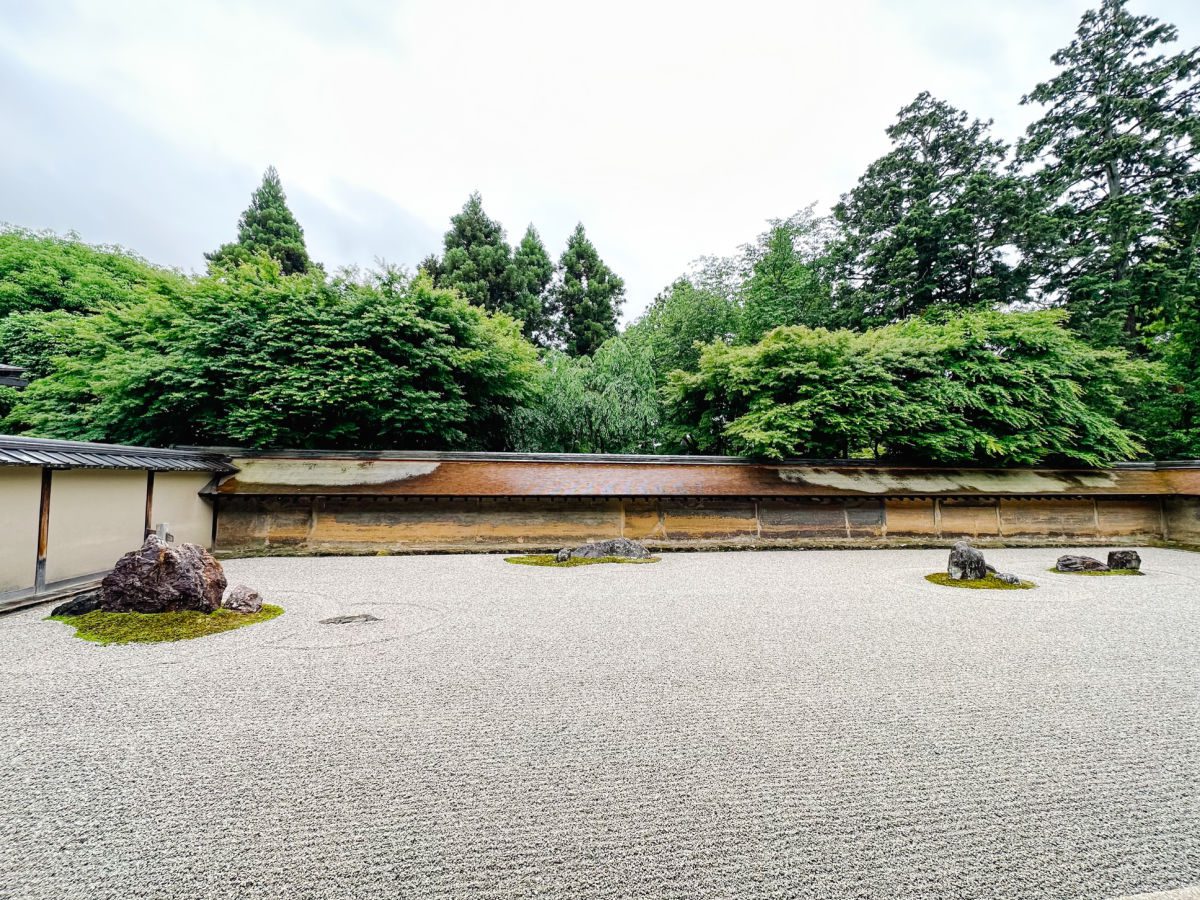
The temple is most famous for its zen rock garden, which is said to be created at the end of the Muromachi Period around 1500 by a highly respected Zen monk, Tokyo Zenketsu. The garden measures only 25 meters from east to west and 10 meters from south to north and features 15 rocks spread out throughout the area on a bed of white gravel. We couldn’t determine any rhyme or reason for the layout or the significance of the number of rocks, but it does have a peaceful quality if you can grab a spot on the edge of the platform to sit and contemplate for a few minutes.
Also on the temple grounds, you will walk past the Kyoyochi Pond, which was the home to mandarin ducks, and therefore, Ryoan-ji was generally known as Oshidoridera, the temple of mandarin ducks.
For lunch, you may want to try Okonomiyaki Katsu near Ryoanji Temple, Omurahouse Kinkakuji closer to the Golden Pavilion (known for its omurice dishes), or go for some conveyor-belt sushi at the popular Kura chain. I tried to get a reservation at Kichikichi for omurice, but wasn’t successful (even after setting a reminder and jumping online right away!)
However, if you want to be more adventurous, take a walk through the Nishiki Market, known as Kyoto’s Kitchen, which specializes in all things food related and is a great place to find seasonal foods and Kyoto specialties, such as Japanese sweets, pickles, dried seafood, and sushi. In addition to these staples, there are many stalls offering prepared food specialties that you can eat on the spot.
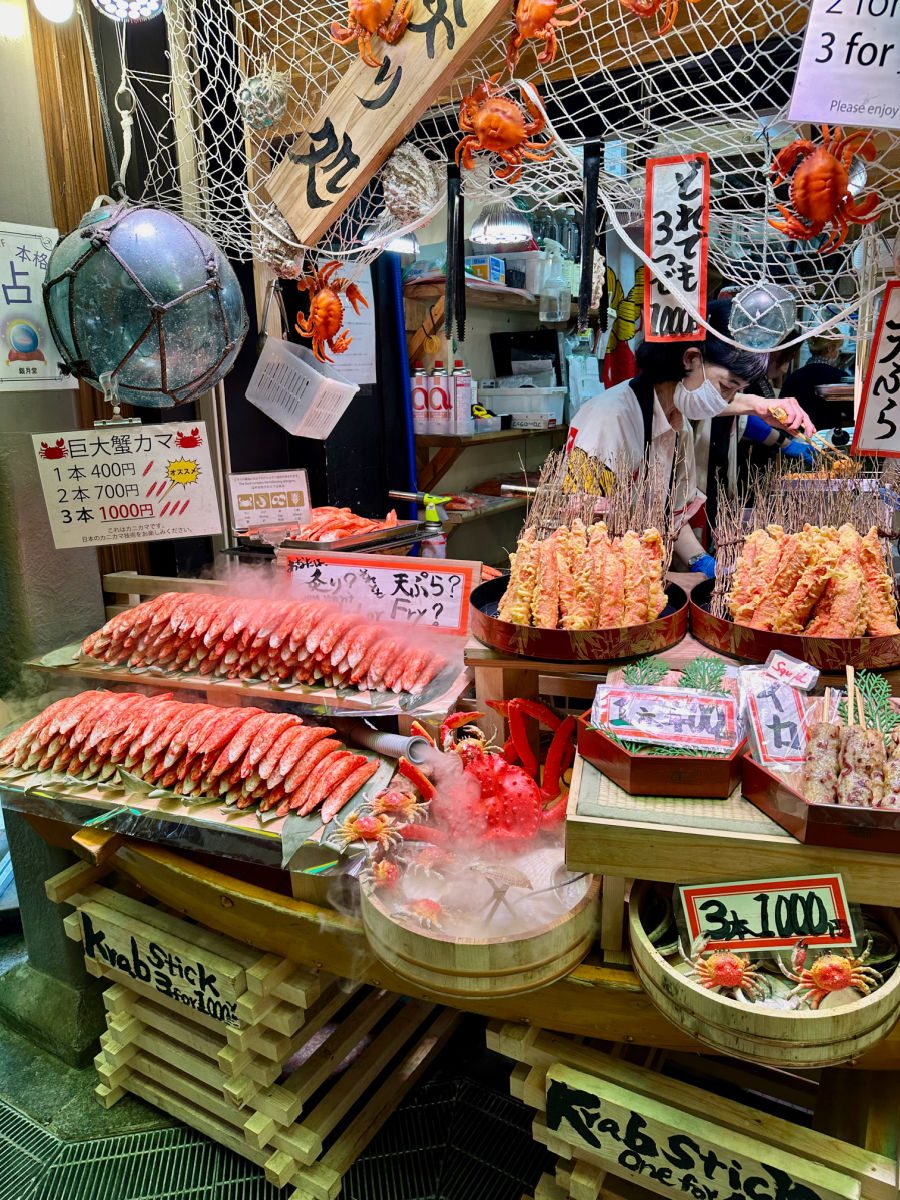
From the Nishiki Market, it is only a 15-minute walk to the Japanese tea ceremony at the Jotokuji Temple. Through the experience, you will be taught the fine art of drinking matcha tea and learn about the importance of the ceremony. We had made a reservation for this tea ceremony, since matcha and tea are so essential to the Kyoto culture, however, we were too tired and soaked from the rain to keep our reservation. It is my one regret, but at the time we really need to get dry and get some rest.
If that tea ceremony experience doesn’t work with your schedule, there are others to choose from, including one located very close to the Golden Pavilion. Some of these tea ceremonies also offer the option to learn about and wear a kimono.
Of course, there are kimono rental shops all over Kyoto and many people do this to explore the temples, visit the bamboo forest, or simply for photo shoots. We debated doing this but had some concerns over cultural appropriation, although we were told that it was not considered inappropriate as long as it was done there with respect (versus taking a kimono home and wearing it as a costume.)
Pontocho Alley
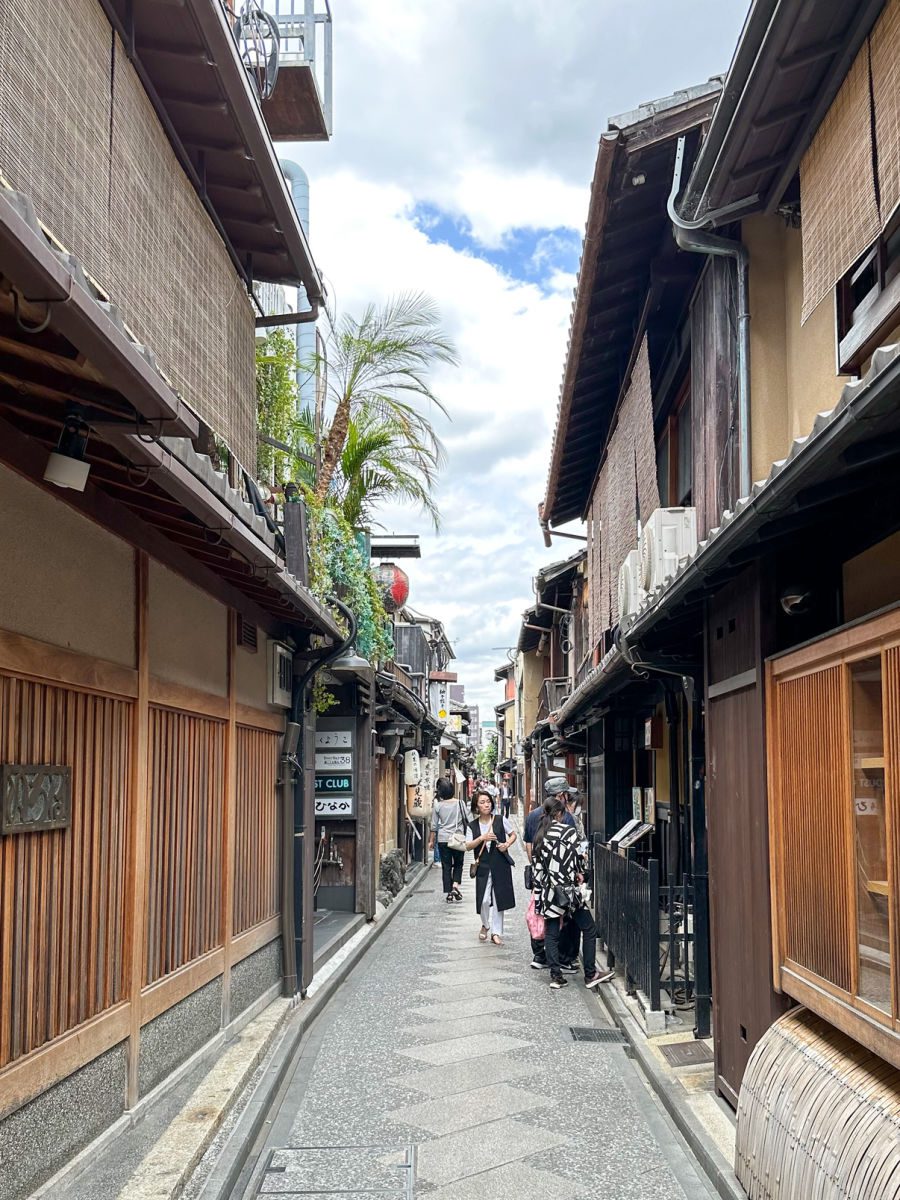
For dinner, you will want to explore Kyoto’s famous Pontocho Alley. This narrow and atmospheric pedestrian street runs parallel to the Kamogawa River and is renowned for its traditional teahouses, restaurants, and bars with a long history dating back to the 16th century.
The alley is lined with traditional machiya buildings and in the evening, the lanterns lining the street are lit, casting a warm glow and adding to the enchanting ambiance. Pontocho Alley provides a variety of dining options, including kaiseki, with some restaurants offering outdoor dining overlooking the river.
We ate in Pontocho Alley twice, trying different cuisines, and would recommend both Yamafuku for a shabu shabu hot pot experience and Ukiya Pontocho for soba noodles and tempura.
Kyoto Itinerary: Day 5
I’ve saved the best for last, which is the Arashiyama ward, located on the northern outskirts of Kyoto. This area is most famous for its beautiful bamboo forest, which gets absolutely swarmed with tourists. While the conventional wisdom is to get there early (by 7:00 am), but since it is 30 minutes outside the city center, we didn’t feel like getting up that early this many days into our busy vacation.
The busiest times tend to be from 10:00 am to 2:00 pm, with plenty of early birds as well. We decided to buck conventional wisdom and visit in the afternoon instead and to be honest, it worked out quite well. We didn’t have to fight any large crowds and there was plenty of space to get some photos without a million other people around.
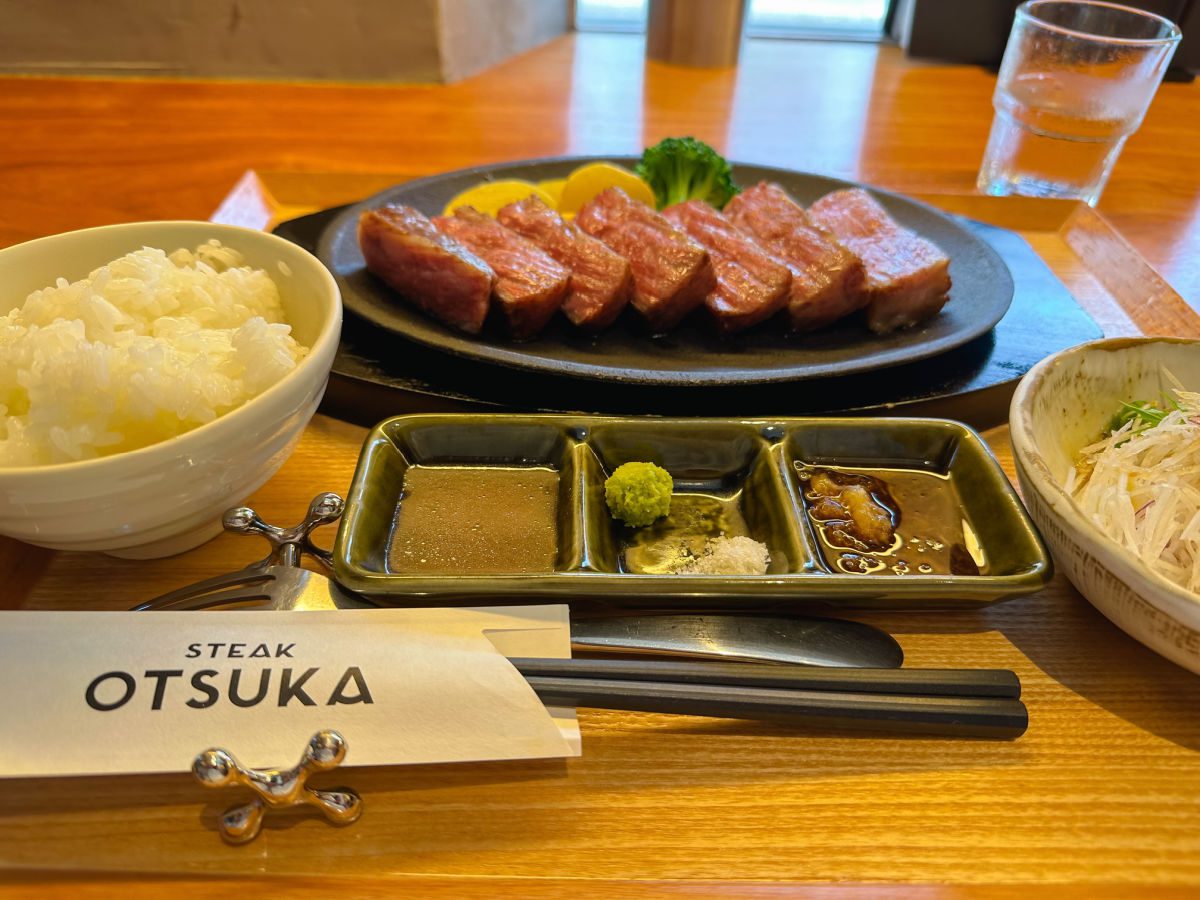
Do what works best for you, but we took the day to sleep in and then went to lunch at Steak Otsuka, which is only a five-minute walk from the train station but off the main drag through Arashiyama. I had to book reservations weeks in advance, but it would be worth the wait if you can’t secure a reservation. They offer A5 Waygu beef and even steak from Murasawa cows, also called “phantom beef” because only 80 cows are used a year. It was honestly one of the best steaks I’ve ever had.
Arashiyama Monkey Park
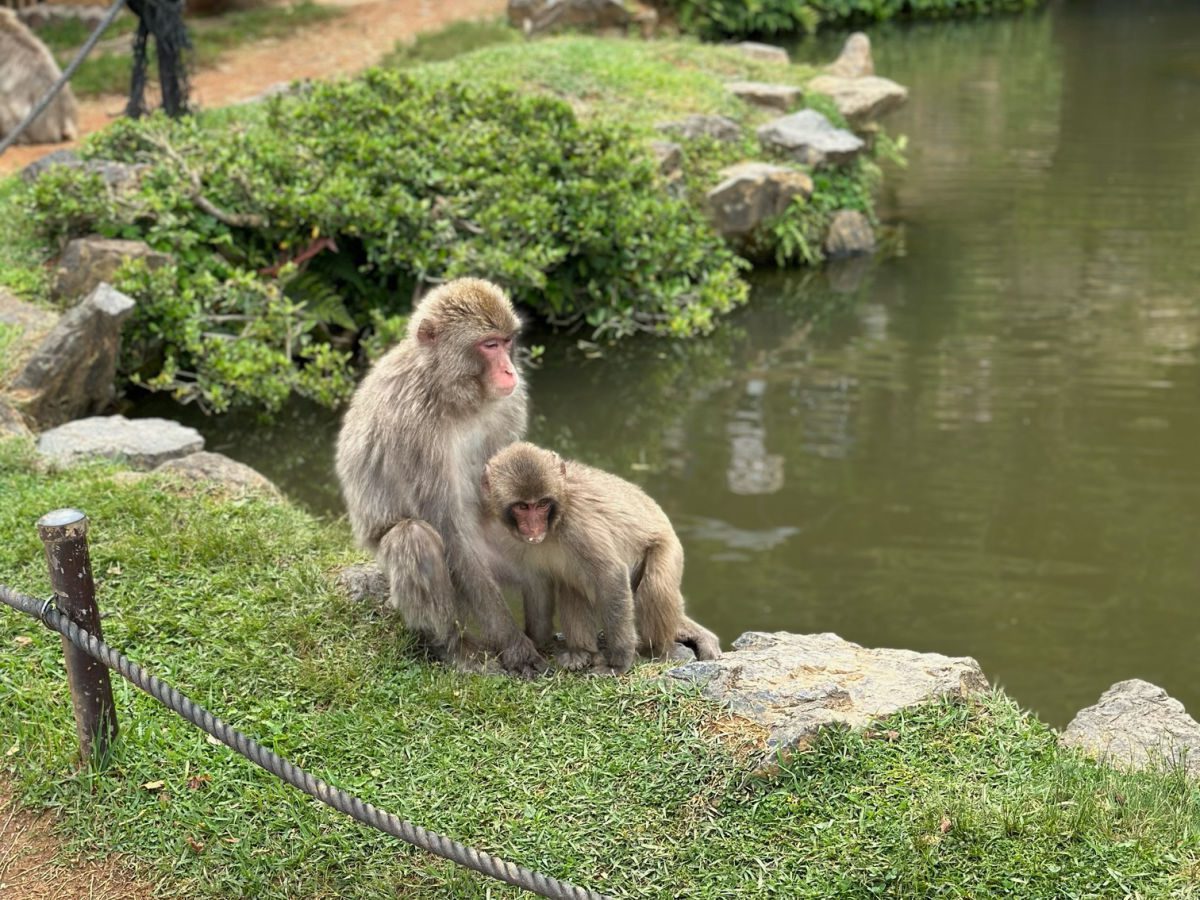
After that lunch, you will be happy to walk through town and across the Togetsukyo Bridge to the Arashiyama Monkey Park to see the Japanese Macaques. Be prepared for a steep, 20 to 30-minute climb up Mt. Arashiyama, where you can then observe and interact with the monkeys in their natural habitat. You can pay to feed the monkeys from inside a building (with the monkeys reaching through bars from the outside), or just spend some time observing them and taking in the view.
When we visited there were many mama and baby duos and watching the babies play was precious. Just be sure to follow the park’s guidelines and rules, such as refraining from touching or feeding the monkeys directly and avoiding looking into their eyes. This ensures the safety of both the visitors and the monkeys.
Tenryū-ji Temple
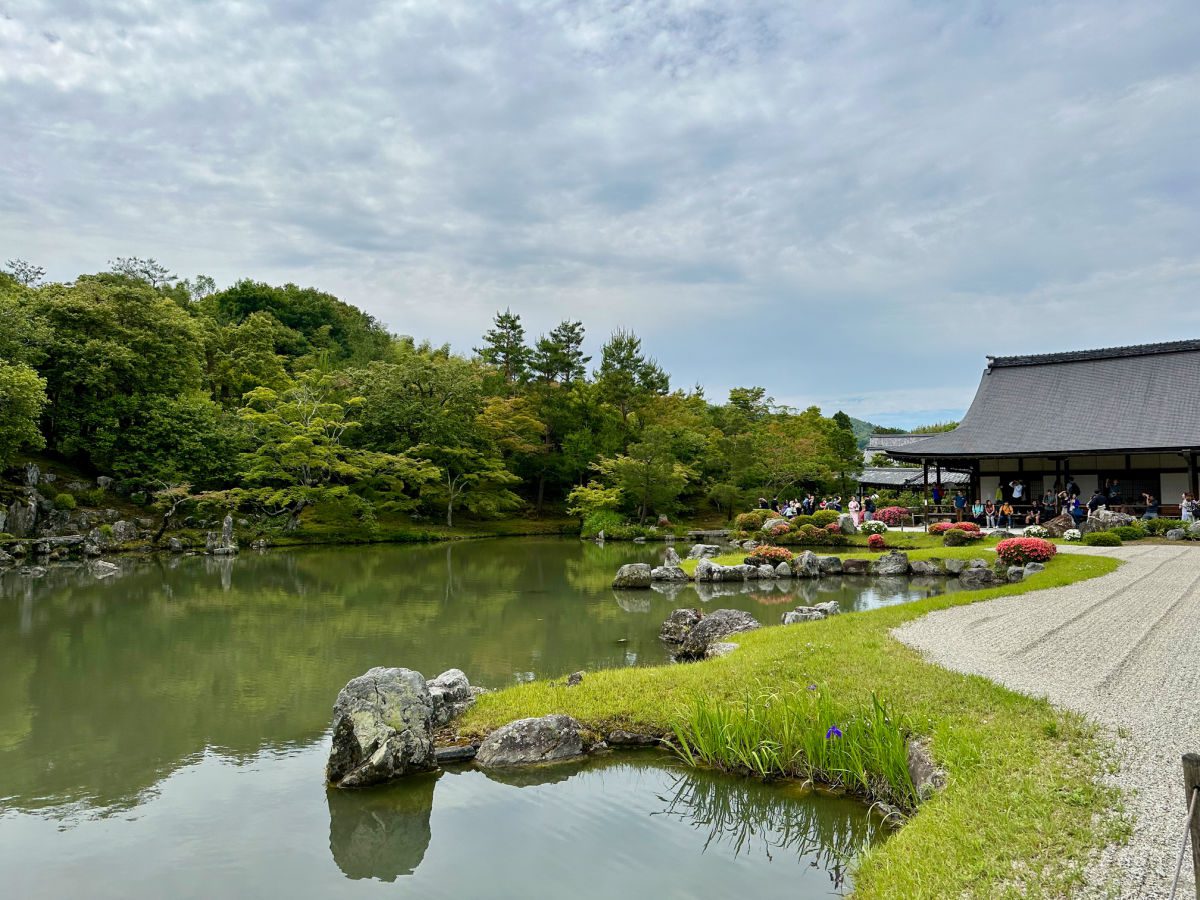
From the Monkey Park, you can walk back across the river (or even take a boat ride) and explore the cute shops and food stalls along the main street. These were surprisingly nice for such a touristy area, and there are so many delicious sweets to try including mochi, taiyaki, soft ice cream, and everything matcha.
Before you get to the turn-off for the Bamboo Grove, you will arrive at the Tenryū-ji Temple. I recommend stopping here first, partially because it helps you avoid the main crush of people walking from the train station straight to the Bamboo Grove.
The Tenryu-ji Temple is a celebrated Zen Buddhist temple that was founded in the 14th century and the temple’s name translates to “Heavenly Dragon Temple,” symbolizing the power and spirituality associated with the mythical creature. As a UNESCO World Heritage site, Tenryuji Temple is renowned for its stunning architecture, serene gardens, and connection to Japan’s Zen Buddhist tradition.
However, I think the best part of the Tenryū-ji Temple is not in the main hall, but in the Hatto Hall, which is home to the Tenryū-ji Cloud Dragon painting by Kayama Matazo. Completed in 1997, the Cloud Dragon is painted on a lacquer and clay base covering the ceiling and it is rendered in the happo-nirami style, in which it appears to look directly at you, no matter which direction you view it from. This illusion is truly fascinating!
If you purchase a combination ticket for the temple and the Sogenchi Garden, you can then exit the garden at the beginning of the main bamboo grove.
Arashiyama Bamboo Grove
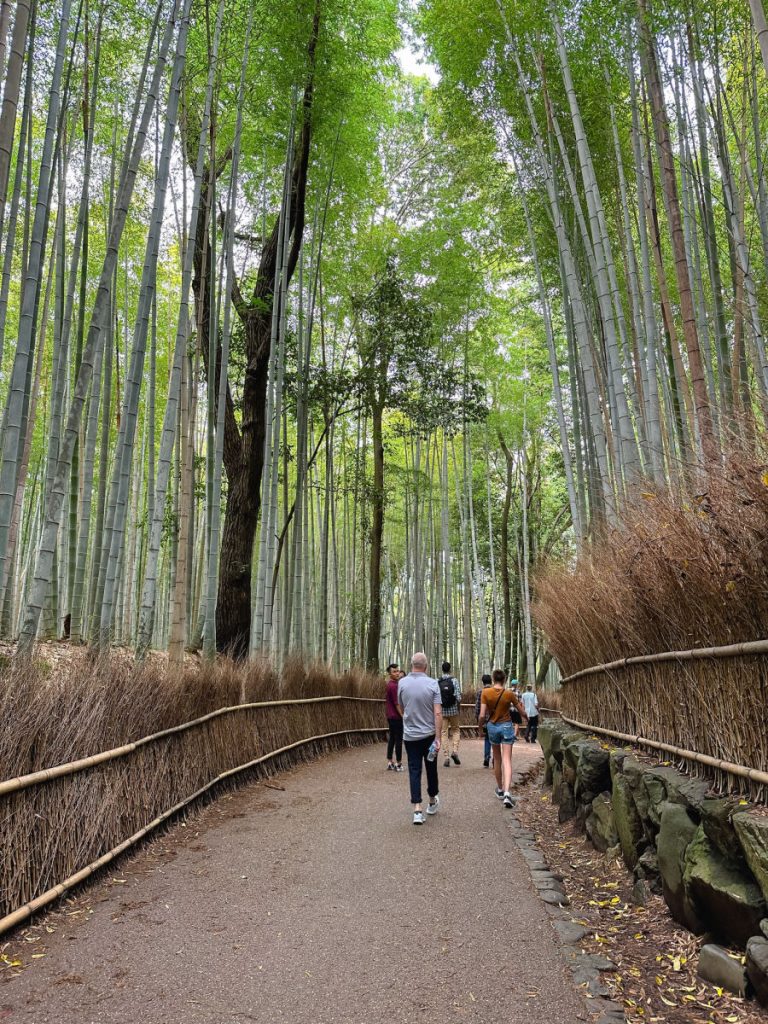
The Arashiyama Bamboo Grove covers an area of approximately 500 meters with towering bamboo stalks and pathways. Due to its photogenic nature, the bamboo grove is a very popular attraction, especially during the mid-day.
As I mentioned earlier, it pays to visit either very early (around 7 am or sunrise) or later in the afternoon when the light filters through the bamboo offering a beautiful photo backdrop. Because this area isn’t as large as people imagine, it can sometimes be a bit of a letdown, especially when it is overcrowded, but I found it quite beautiful. If you make a day (or a half-day) of exploring this whole area, a visit to the Arashiyama Bamboo Grove is definitely worth it.
If you have a bit more time, you may want to take a taxi or hop on a bus to visit Otagi Nenbutsu-ji, which is about a 20-minute drive from the bamboo grove, in a quiet, wooded part of the city. The temple is surrounded by 1,200 Buddhist Rakan statues, each of which is slightly different.
For dinner, we finished up our time in Kyoto at a high-end, set menu at Tempura Endo in Gion. At this traditional-style restaurant, the tempura is prepared in front of you and served individually. There were some standard options, like shrimp, asparagus, and eggplant, but also special courses like a mushroom with truffle.
Getting to Kyoto
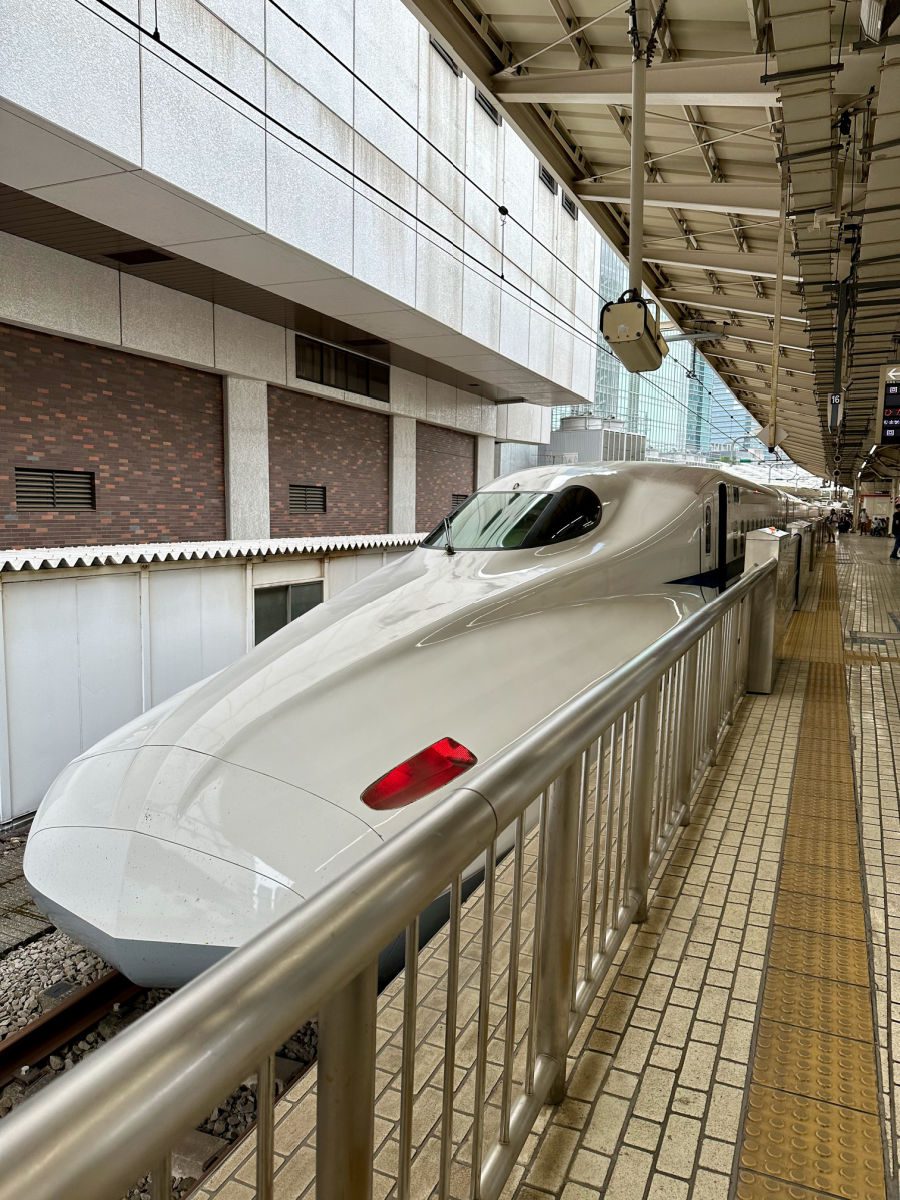
Whether you’re coming from within Japan or traveling internationally, you have several convenient options to reach Kyoto. If you’re already in Japan, the iconic Shinkansen bullet train provides a seamless and efficient way to travel to Kyoto. From Tokyo, hop on the Nozomi (not included in the JR Pass) or Hikari Shinkansen, and in just under 2.5 hours, you’ll arrive at Kyoto Station, located in the heart of the city. If you can, sit on the right side of the train from Tokyo to Kyoto and you will have a great view of Mount Fuji on a clear day.
Similarly, if you’re coming from Osaka, the journey to Kyoto on the Shinkansen takes a mere 15 minutes, making it an incredibly convenient option for day trips or exploring the region. You can also use local JR Trains from Osaka to reach Kyoto in only 30 minutes.
For international travelers heading directly to Kyoto, you will need to fly into Kansai International Airport (KIX) or Itami Airport (ITM), both located near Osaka. From there, you can take a direct train or bus to Kyoto, which typically takes around 75 minutes from KIX or 50 minutes from ITM.
Where to Stay in Kyoto
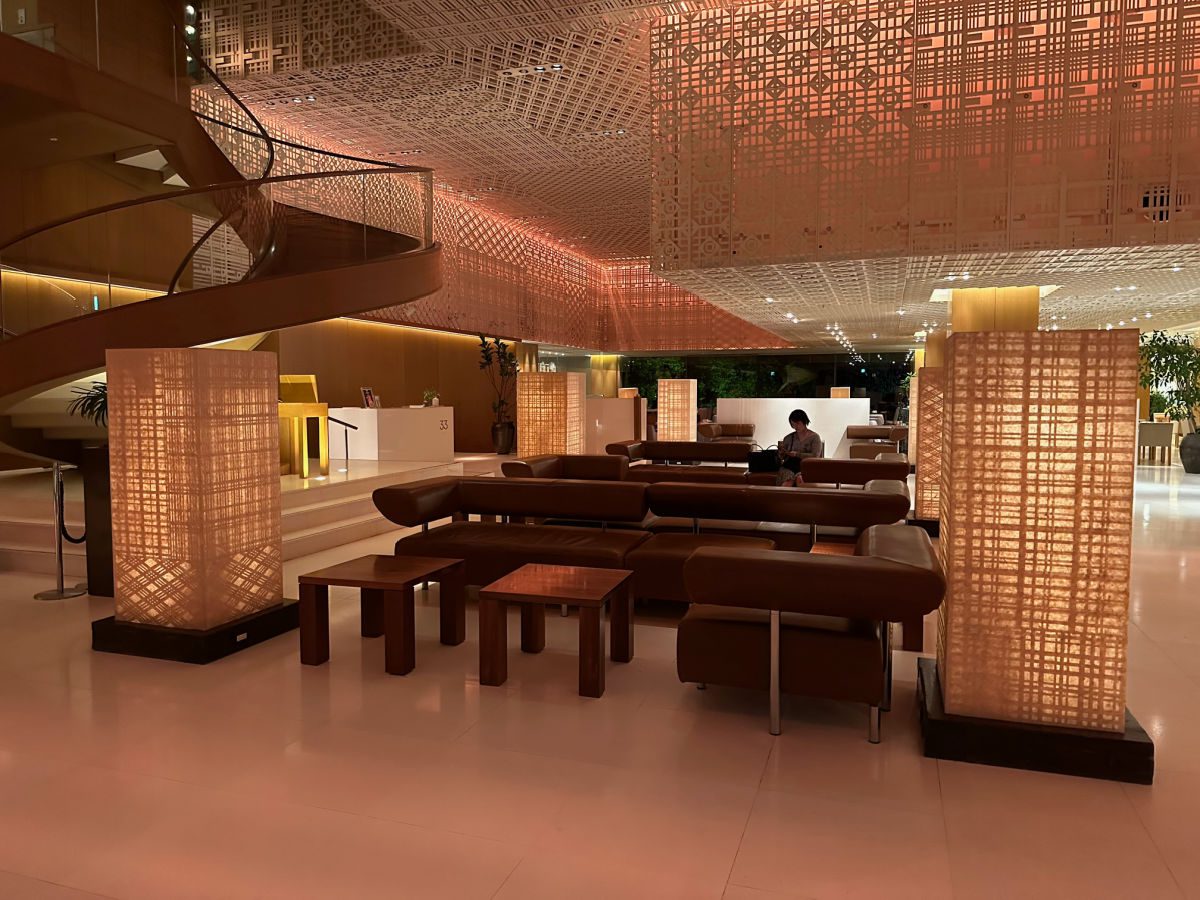
Even if Kyoto doesn’t compare to Tokyo or Osaka in size, it is still a large city, and choosing a place to stay that is located close to public transportation options is important. One thing to note about Kyoto is that it isn’t as easy to get around as Tokyo, as the Metro system isn’t as developed. There are a few train lines (both JR and Kintetsu), but you will likely need to also use buses and take a few cabs occasionally.
Central Kyoto is where you will find the most options for all price ranges and it will be convenient to the Kyoto Station, but it doesn’t have the charm and historical appeal of some of the other areas. The historic Gion district offers a glimpse into traditional Japan. Stay in this area to experience the atmospheric streets lined with machiya townhouses, tea houses, and exclusive dining options. However, the options in Gion tend to be quite pricey.
The Higashiyama ward, situated on the eastern side of Kyoto, will put you within easy walking distance to Gion and several notable attractions, while also connecting you to other parts of the city through nearby train and bus options.
When choosing where to stay in Kyoto, I wanted a hotel that was within walking distance of some major attractions and with easy access to public transportation. I chose the Hyatt Regency Kyoto in the Higashiyama Ward because it was right next to a bus stop that went to the main train station for a JR train and it was also within a less-than-10-minute walk to the Kintetsu train station.
The hotel also provides a complimentary one-way taxi ride using MK Taxis from the train station to the hotel. There were many temples and shrines nearby and it is a 15-minute walk to the popular Gion district.
As you will find throughout Japan, the service at the Hyatt Regency was exceptional. We really enjoyed the rooms, although I really wish architects would move away from the open bathroom plan. In our rooms, the bathroom was behind a wall, but there was no door to separate the shower and sink from the main room. But the beds were comfortable, housekeeping was good, and we loved the location.
Breakfast wasn’t included so we never ended up eating at the hotel, but they do offer a breakfast buffet (for about $30 per person), an Italian restaurant, a Japanese restaurant, and a pastry shop that has limited hours. One thing to note is that on a few nights a week, they have a short Maiko performance (about 10 minutes) between 6:00-6:30 pm on the lower level outside of the Japanese restaurant. This is a great way to get a small cultural experience for free.
Find other places to stay in Kyoto:
Visiting Japan? Read more…
If you are planning a visit to Japan, be sure to also check out the following articles:
- 14-day Japan itinerary
- How much does a trip to Japan cost?
- 75+ Japan travel tips
- 5 Days in Tokyo itinerary
- 3 Days in Osaka itinerary
Save this to Pinterest
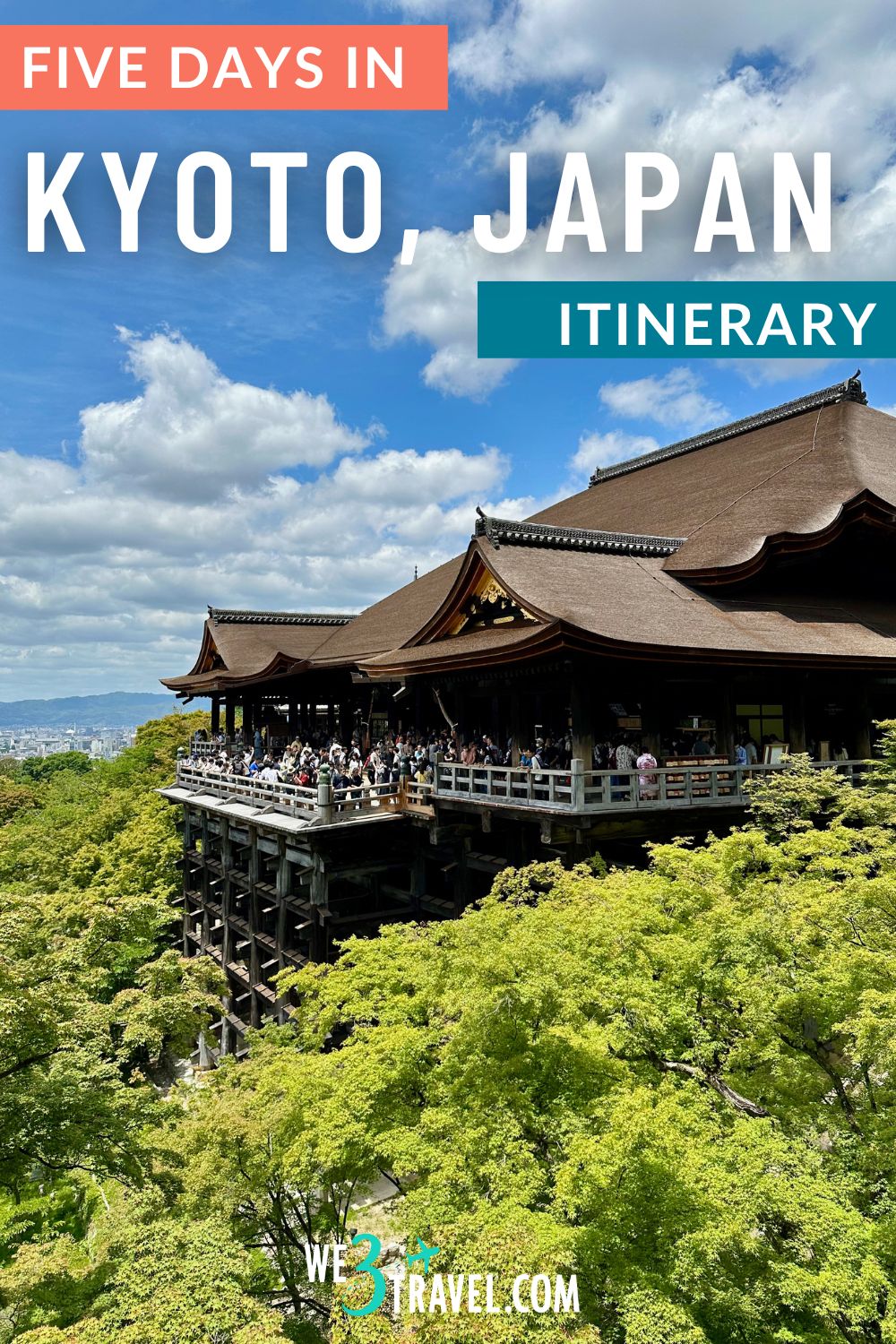

Tamara Gruber is the Founder and Publisher of We3Travel. A former marketing executive and travel advisor, Tamara is an award-winning travel writer and recognized expert in family travel. Tamara is a member of SATW, NATJA, IFWTWA, and the Adventure Travel Trade Association, and serves on the Board of the Family Travel Association. She is also the publisher of YourTimetoFly.com and the co-host of the Vacation Mavens travel podcast.


